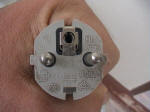| |
Grounded electric is not yet a standard here. Most appliances only
have 2 prongs, like the following example shows. This two pronged plug has a position to add a ground, and it can easily
be modified by adding a round piece of metal as the ground. This
isn't the only type of plug, there are many variations, from the round
posts to straight posts. As of the current date most house
electrical is not grounded, but that is slowly changing. To turn
on the electric service now an inspector from the electric company will require grounded
electric, but the inspection I observed wasn't very thorough. The
inspector only asked about how the system was grounded, but did not
check. There are simple voltage meters which can check voltage as
well as the ground. Also, the same inspector then immediately
approved a house that I know doesn't have grounded electric.
Anyway, the point is that they are starting to require grounded
electrical here and there really isn't any reason for new construction
not to have it. As an added note to clarify: they are not
requiring that all (or any) socket outlets in the house be grounded, only that
there be a ground connection from the breaker.
This two pronged plug has a position to add a ground, and it can easily
be modified by adding a round piece of metal as the ground. This
isn't the only type of plug, there are many variations, from the round
posts to straight posts. As of the current date most house
electrical is not grounded, but that is slowly changing. To turn
on the electric service now an inspector from the electric company will require grounded
electric, but the inspection I observed wasn't very thorough. The
inspector only asked about how the system was grounded, but did not
check. There are simple voltage meters which can check voltage as
well as the ground. Also, the same inspector then immediately
approved a house that I know doesn't have grounded electric.
Anyway, the point is that they are starting to require grounded
electrical here and there really isn't any reason for new construction
not to have it. As an added note to clarify: they are not
requiring that all (or any) socket outlets in the house be grounded, only that
there be a ground connection from the breaker.
During the building of a house, adding
grounded electrical is not expensive. The additional cost would be
the cost of the ground wire, which will need to be run to each
receptacle, the cost of the grounding rod and wire, and the cost of
grounded sockets. Grounded sockets are quite a bit more expensive than
ungrounded, but they still are not very expensive, ie. a ungrounded
socket
costs about 8 Baht, a grounded one costs more than 70 Baht. If a house
is done without being grounding it would be very expensive to redo it later
to add the ground. One of the primary motivations to build a house
(for me) instead of renting is that previous rental houses didn't have
grounded electrical. I would get shocked just by looking at my
computer! OK, maybe that is a bit of an overstatement, but with
the computer, if I wanted to hook up something (like a USB device) I
would shut the computer down and turn off the electric surge protector.
Even after the surge protector was turned off I would still get shocked!
And touching the computer when turned on would lead to a nasty shock.
Now, after living in a house with grounded electric, I would never go
back to ungrounded.
Some other things which should be
considered before starting on your building project. Normally the
electric is run directly from the street into the roof of the house.
A somewhat fancier option is to run the wire underground from the meter
into the house. The approach should be decided at the onset of
construction. This now brings us to an important topic, the
electric plan. Normally it is done on the fly, but I can see the
advantage to having an electrician do up an electric plan up front. The
electric layout is not a part of the regular plan (blueprint) done by an architect.
Depending on the complexity, it might be useful to have a official plan
done before starting construction. It isn't hard to find
electrical subcontractors who will do a plan, but I'm not sure of the
cost involved. As an alternative, talk to the electrician about
all the options up front and have him rough sketch the plan with you.
Electric is necessary during the
construction process for tools and other necessities. An
application can be made at the electric office for 'temporary' electric
which the regulations state should not be used more that 6 months.
Your electrician will
prepare a place for a temporary meter on the nearest electric post.
The electric department will then come out and inspect and, if it passes,
hook up the temporary meter. You can then have the electric wire
run from the meter to the building site. There is a deposit
required at the
Bang La Mung electric department (Pattaya) to activate the temporary
electric of 10,000 Baht.
Whether buying or building a house, a good
thing to check for is electrical conduit. There are two types,
PVC and metal. It shields and the electric wire from all kinds of
things, and because of the fact that there really are no inspections
here, it is often omitted.
|
|

